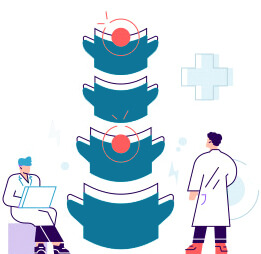By clicking on the "Get a consultation" button, you agree to the privacy policy

Or contact us via messenger


8 800 999-99-99
Show MRI
Every day from 8am to 8pm
REDUCING AN INTERVERTEBRAL HERNIA WITHOUT SURGERY
In the neck, right or left arm with a hernia in the cervical spine
Decreased skin sensitivity (numbness)
Muscle weakness and motor disorders (for example, paresis of the foot)
In the lower back and legs with a hernia in the lumbar spine
Disorders of the pelvic organs (with lumbar hernia)
Herniated disc is a very common disease. Pain is the main sign of this ailment. The main symptoms of hernia:
Causes of the disease?
Over the course of a lifetime, the disc wears out, ages prematurely and becomes less resistant to all kinds of stress. Scientifically, this is called degenerative changes in the disc. It is important to know that heredity, smoking, impaired disc nutrition and excessive load increase the likelihood of the degeneration process and therefore possible disc damage and herniation.
- Smoking
- Heredity
- A predisposition to accelerated disc ageing can be passed on from ancestors to descendants at a genetic level.

If the external load exceeds the strength of the disc, it causes microcracks and increases the chance of a herniated disc. Damage can be caused by, for example, sudden movements, lifting heavy weights and professional sports.
Excessive load

There are no blood vessels in the disc and all the necessary nutrition seeps into it from the vertebrae. This happens when the disc is compressed rhythmically while walking.
If a person doesn't walk much - for example, due to office work - the necessary nutrients are insufficient and the disc cells begin to die. This is degeneration, in which the fibrous ring becomes less elastic and its strength decreases.
If a person doesn't walk much - for example, due to office work - the necessary nutrients are insufficient and the disc cells begin to die. This is degeneration, in which the fibrous ring becomes less elastic and its strength decreases.
Nutritional disturbance
Get an online consultation on MRI images
Show an MRI to a doctor

You will find out if it is possible to cure a hernia without surgery in our clinic

3 treatment options for herniated disc


Without surgery


Quick recording via messenger




The intervertebral hernia is removed to relieve nerve root compression. This is the fastest and also the riskiest method of treatment. Surgery does not always relieve a person of pain and does not prevent recurrences. The option of surgical treatment should only be considered in extreme cases.
Surgery

This is a complex conservative treatment aimed not only at reducing pain, but also at reducing the size or completely eliminating an intervertebral herniation of the disc. The method began to develop relatively recently, but it has already become an alternative to the usual choice between surgery and prolonged pain relief. The Tkachev Epifanov Clinic is the first in Russia to use it in the treatment of patients.
Modulated herniated disc resorption

Its aim is to reduce inflammation in the herniated disc area with the help of a combination of procedures and medication. This method is more of a symptomatic therapy: it can temporarily reduce pain, but it does not change the condition of the intervertebral disc and does not eliminate the hernia.
Conservative treatment
What is an intervertebral hernia resorption?
In medicine, the term 'resorption' refers to the dissolution of something: e.g. a hernia, bone tissue, etc. How does it happen? When a hernia occurs, the body perceives it as an intervertebral disc wound (similar to a cut on your finger, for example) and begins the healing process. Inflammation occurs around the hernia. Nerve endings and blood vessels gradually grow into it, through which macrophage cells enter the hernia. They dissolve it, so that eventually the hernia can shrink or disappear completely.
Resorption for a herniated disc is a normal healing process

Probability of conventional and modulated resorption
0%
Natural resorption not helped by special procedures
Probability of onset
From 15 months
0%
Average time to treat a hernia with modulated resorption
Probability of onset
6 months
Composition of the method
Acupuncture
Pain relief, muscle tension release, stimulation of tissue nutrition
Pharmacopuncture
Stimulation of physiological inflammation, ligaments strengthening
Magnetotherapy
Relief of pain and muscle tension, muscles strengthening, joint mobility increasing
Laser therapy
Relief of pain, inflammation, swelling, accelerated healing process.
Medication
Acute and chronic pain relief.
PRP therapy
Stimulation of physiological inflammation, pain relief and regeneration.
The main questions of our patients
Do you have any additional questions?
Leave your contacts, we will call you back:
Or contact us via messenger



On average, treatment consists of 2-3 courses of 12 procedures each. Each treatment is followed by a break of 1.5-3 months, during which the patient is observed by the attending physician and, if necessary, undergoes a second MRI scan.
Based on experience and clinical data, the Tkachev-Epifanov method reduces the duration of resorption by half and sometimes three times and increases the treatment success rate to 94%. The average time to hernia reduction (resorption) in the clinic is 4-6 months.
Based on experience and clinical data, the Tkachev-Epifanov method reduces the duration of resorption by half and sometimes three times and increases the treatment success rate to 94%. The average time to hernia reduction (resorption) in the clinic is 4-6 months.
Allows you to avoid surgery, even if it is indicated
Uses a neurosurgical approach in neurology
Addresses the cause of pain
Raises fundamentally new challenges in conservative treatment
Stimulates the natural process in the human body
Offers a new perspective on the use of medicines
Uses a neurosurgical approach in neurology
Addresses the cause of pain
Raises fundamentally new challenges in conservative treatment
Stimulates the natural process in the human body
Offers a new perspective on the use of medicines
Long-term use of non-steroidal anti-inflammatory drugs
Older age, which slows down self-healing and regeneration processes
Additional traumatisation of the disc in the acute period: sports activities, massage, etc.
The use of medical drug blockades with hormonal drugs not only significantly extends the time of resorption, but also greatly reduces its likelihood.
Older age, which slows down self-healing and regeneration processes
Additional traumatisation of the disc in the acute period: sports activities, massage, etc.
The use of medical drug blockades with hormonal drugs not only significantly extends the time of resorption, but also greatly reduces its likelihood.
On average, treatment consists of 2-3 courses of 12 procedures each. Each treatment is followed by a break of 1.5-3 months, during which the patient is observed by the attending physician and, if necessary, undergoes a second MRI scan.
Based on experience and clinical data, the Tkachev-Epifanov method reduces the duration of resorption by half and sometimes three times and increases the treatment success rate to 94%. The average time to hernia reduction (resorption) in the clinic is 4-6 months.
Based on experience and clinical data, the Tkachev-Epifanov method reduces the duration of resorption by half and sometimes three times and increases the treatment success rate to 94%. The average time to hernia reduction (resorption) in the clinic is 4-6 months.
Allows you to avoid surgery, even if it is indicated
Uses a neurosurgical approach in neurology
Addresses the cause of pain
Raises fundamentally new challenges in conservative treatment
Stimulates the natural process in the human body
Offers a new perspective on the use of medicines
Uses a neurosurgical approach in neurology
Addresses the cause of pain
Raises fundamentally new challenges in conservative treatment
Stimulates the natural process in the human body
Offers a new perspective on the use of medicines
Long-term use of non-steroidal anti-inflammatory drugs
Older age, which slows down self-healing and regeneration processes
Additional traumatisation of the disc in the acute period: sports activities, massage, etc.
The use of medical drug blockades with hormonal drugs not only significantly extends the time of resorption, but also greatly reduces its likelihood.
Older age, which slows down self-healing and regeneration processes
Additional traumatisation of the disc in the acute period: sports activities, massage, etc.
The use of medical drug blockades with hormonal drugs not only significantly extends the time of resorption, but also greatly reduces its likelihood.
Do you have any additional questions?
Leave your contacts, we will call you back:
Or contact us via messenger




The results speak for themselves

Treatment of recurrence after surgery
Male, 55 years old. Has been experiencing back pain more frequently for the last 7 years. He was successfully operated. A year later pain returned, MRI showed recurrence of L4-L5 hernia 9 mm
Male, 55 years old. Has been experiencing back pain more frequently for the last 7 years. He was successfully operated. A year later pain returned, MRI showed recurrence of L4-L5 hernia 9 mm

Cured 27 mm sequestrated disc herniation in 2 courses
Female, 25 years old. Professional athlete. Suddenly felt pain in her back and left hip. MRI revealed sequestered hernia L5-S1 27 mm. Relieved of nine-point pain caused by a herniated disc
Female, 25 years old. Professional athlete. Suddenly felt pain in her back and left hip. MRI revealed sequestered hernia L5-S1 27 mm. Relieved of nine-point pain caused by a herniated disc

Relieved of nine-point pain caused by a herniated disc
Male, 49 years old. Experienced intermittent neck pain. Patient came in with acute pain in the neck when bending the head. Cervical MRI showed a herniated disc C6-C7 10 mm
Male, 49 years old. Experienced intermittent neck pain. Patient came in with acute pain in the neck when bending the head. Cervical MRI showed a herniated disc C6-C7 10 mm

Unbearable pain at 10 on VAS
Female, 25 years old. Came to the clinic with intolerable pain in the lumbosacral region of her back scoring 10 on the VAS scale. MRI showed herniated L5-S1 up to 11.7 mm
Female, 25 years old. Came to the clinic with intolerable pain in the lumbosacral region of her back scoring 10 on the VAS scale. MRI showed herniated L5-S1 up to 11.7 mm
More than 3,000 satisfied patients have already got rid of back pain and reduced hernia without surgery!
Our results that we are proud of
- Treatment of recurrence after surgery
- Cured 27 mm sequestrated disc herniation
- Relieved of nine-point pain
- Unbearable pain at 10 on VAS
Male, 55 years old. Has been experiencing back pain more frequently for the last 7 years. He was successfully operated. A year later pain returned, MRI showed recurrence of L4-L5 hernia 9 mm
Treatment of recurrence after surgery
Female, 25 years old. Professional athlete. Suddenly felt pain in her back and left hip. MRI revealed sequestered hernia L5-S1 27 mm. Relieved of nine-point pain caused by a herniated disc
Cured 27 mm sequestrated disc herniation in 2 courses
Male, 49 years old. Experienced intermittent neck pain. Patient came in with acute pain in the neck when bending the head. Cervical MRI showed a herniated disc C6-C7 10 mm
Relieved of nine-point pain caused by a herniated disc
Female, 25 years old. Came to the clinic with intolerable pain in the lumbosacral region of her back scoring 10 on the VAS scale. MRI showed herniated L5-S1 up to 11.7 mm
Unbearable pain at 10 on VAS

Step 1
Provide rest during the acute period
Step 2
If possible, refrain from performing blockades
Step 3
Get a face-to-face consultation with a neurologist or vertebrologist
Step 4
Get an MRI scan of the corresponding region of the spine


Algorithm of action if a hernia occurs
Step 5
Follow the prescription of the attending physician and achieve resorption





